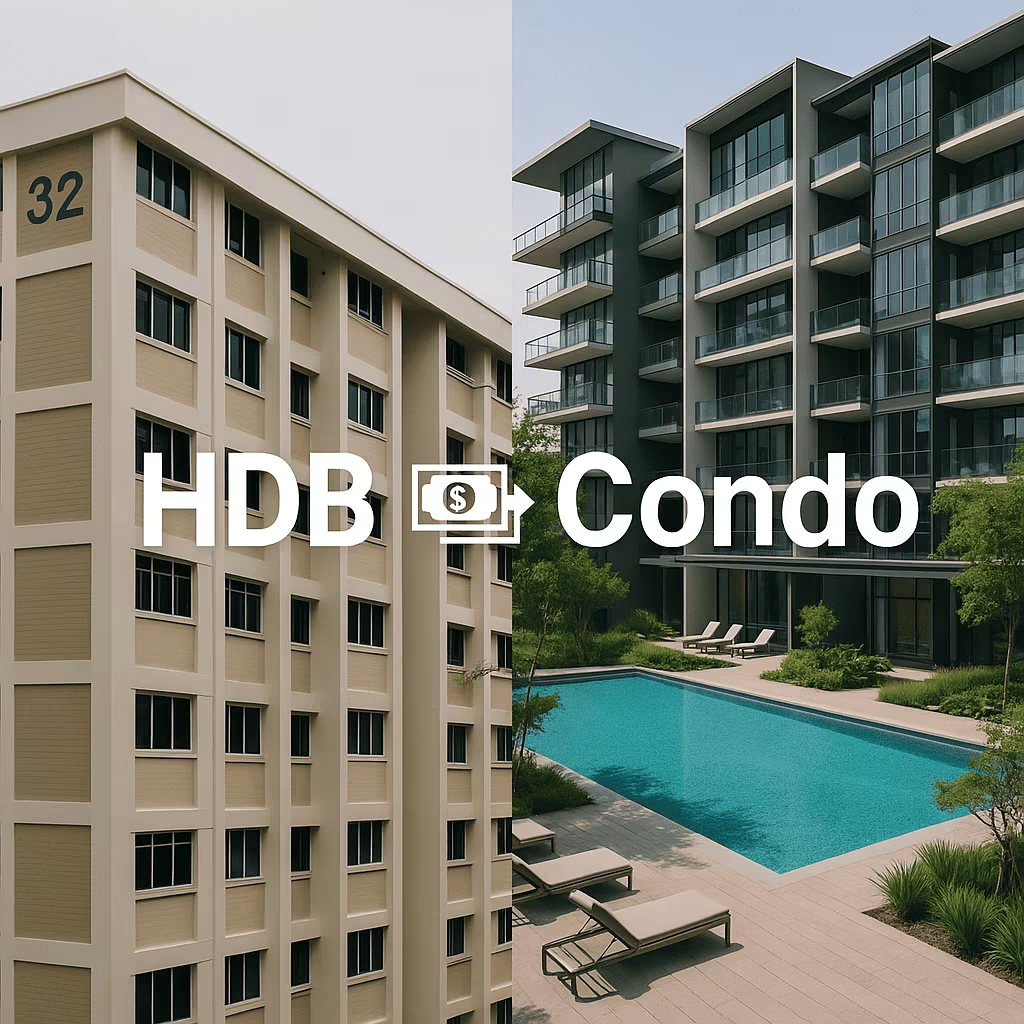Guide to Bridging Loans for HDB to Condo Upgraders
Upgrading from your HDB flat to a private condominium is an exciting milestone. But many homeowners hit the same roadblock:
“How do I pay for my new condo’s downpayment before my HDB sale proceeds come in?”
That’s where a HDB bridging loan comes in. Think of it as a short-term helping hand — a temporary boost to cover the cash flow gap so you can secure your condo without waiting months for your HDB sale to complete.

Table of Contents
ToggleWhat Exactly Is a Bridging Loan?
A bridging loan is a short-term, temporary loan designed to “bridge” the financial gap between two property transactions. For HDB owners, it allows you to secure the downpayment for your new condo while waiting for the sales proceeds from your existing HDB flat.
This loan is secured against the expected net proceeds and/or CPF funds from the sale of your HDB. It is important to note that a bridging loan is distinct from a long-term mortgage and is not a substitute for it. The loan tenure is short, usually up to six months, and repayment is expected in a single lump sum once your HDB sale is completed.
How it Works: The HDB to Condo Upgrade Process
The process of using a bridging loan to upgrade from a HDB to a condo involves three main steps:
- Purchase of the New Condo: You find a condominium and sign the Option to Purchase (OTP), which requires you to pay the booking fee. Following this, you must pay the remaining portion of the downpayment. The downpayment for a private property in Singapore is typically 25% of the purchase price, with a minimum of 5% in cash. The remaining 20% can be paid with cash or CPF.
- Sale of the Existing HDB: You must have a buyer for your HDB flat and have signed the OTP. This is a critical prerequisite for most banks to approve a bridging loan, as it demonstrates a clear repayment source. Some banks may even require the sale OTP to be exercised before granting a bridging loan.
- Application for a Bridging Loan: You apply for a bridging loan from a bank to cover the downpayment for the condo. The loan quantum is based on the expected net proceeds and CPF funds from your HDB sale. Once your HDB sale is completed and the proceeds are released, you use them to repay the bridging loan in full.
Types of Bridging Loans
In Singapore, there are generally two types of bridging loans available, each with a different repayment structure:
- Capitalised Interest Bridging Loan: The interest on the bridging loan is not paid on a monthly basis. Instead, it is added to the principal loan amount, and the total is repaid in a lump sum at the end of the loan tenure. This can be useful for those who prefer to avoid servicing two loans simultaneously (the existing HDB loan and the bridging loan).
- Simultaneous Repayment Bridging Loan: With this option, you are required to make monthly interest payments on the bridging loan throughout the tenure. The principal is then paid off in a single lump sum when you receive the HDB sale proceeds. While this requires managing cash flow for two loans, it may result in a lower overall interest cost.
Key Considerations Before Taking a Bridging Loan
Cash Flow Timelines
A bridging loan addresses the difference in cash flow timelines between your HDB sale and condo purchase:
- HDB Sale Proceeds:You receive the cash proceeds from your HDB sale on the day of completion itself, usually via a cashier’s order or direct credit to your bank account.
- CPF Refunds: The CPF funds used for your HDB flat, along with accrued interest, are refunded back to your CPF Ordinary Account (OA). This process can take up to two weeks after the HDB sale completion, and these funds must be back in your OA before you can use them for your new condo purchase.
Therefore, a HDB bridging loan acts as a temporary advance on your expected cash and CPF proceeds, allowing you to pay for the new condo’s downpayment and related costs before your HDB sale proceeds are fully disbursed.
Eligibility and Loan Quantum
Your eligibility for a bridging loan is closely tied to the sale of your HDB flat. Banks will require a signed OTP for your HDB to assess the expected proceeds. The loan amount you can borrow is typically capped at the amount of these proceeds and your available CPF funds.
Interest Rates and Costs
Bridging loans generally have higher interest rates than standard home loans, with rates ranging from approximately 5% to 6% per annum. While the tenure is short, it is crucial to understand the total interest cost and any administrative fees involved.
Total Debt Servicing Ratio (TDSR)
When applying for a new condo loan, your Total Debt Servicing Ratio (TDSR) will be assessed. TDSR limits a borrower’s total debt repayments (including car loans, credit card debt, and the new mortgage) to 55% of their gross monthly income. Even though a bridging loan is short-term, it may be factored into the TDSR calculation, potentially affecting the maximum mortgage amount you can borrow for your condo.
Comparison of Options
Consider your financial situation and risk tolerance before committing to a bridging loan.
Summary
A bridging loan is a practical option for HDB owners in Singapore looking to upgrade to a private condominium, providing the necessary liquidity for the downpayment without the strain of a significant cash outlay. While it is a short-term facility with higher interest rates, it is an effective tool to bridge the financial gap until the proceeds from your HDB sale are received. For professional advice on navigating your options, consider consulting a trusted mortgage advisor, such as those at The Loan Connection.
What is the main purpose of a HDB bridging loan for an HDB upgrader?
Its main purpose is to provide the cash needed for the downpayment on a new condominium before the sale of the existing HDB flat is finalized and the proceeds are received.
How long is the tenure for a typical bridging loan?
The tenure for a bridging loan is short-term, usually lasting up to six months.
Do I need to have a buyer for my HDB flat before I can apply for a HDB bridging loan?
Yes, most banks require you to have a signed Option to Purchase (OTP) from a buyer for your HDB flat. This serves as proof of a guaranteed repayment source for the loan.
Are the interest rates for bridging loans high?
Yes, bridging loans typically have higher interest rates than standard long-term home loans, generally ranging from 5% to 6% per annum.
How does a bridging loan affect my Total Debt Servicing Ratio (TDSR)?
The bridging loan may be factored into your TDSR calculation by the bank. This could potentially reduce the maximum home loan amount you are eligible to borrow for your new condominium.
Disclaimer:
The information provided in this blog is for general informational purposes only and does not constitute financial advice. While The Loan Connection (TLC) strives to ensure accuracy, we make no guarantees as to the completeness, reliability, or timeliness of the information. Readers are encouraged to verify details independently and consult qualified professionals before making any financial decisions. TLC is not liable for any losses or damages arising from reliance on the content herein.

